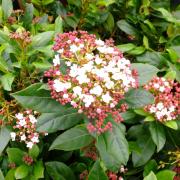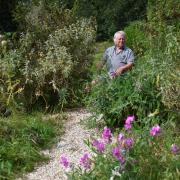Plant specialist Keith Clouting of Taverham Nursery shares his seasonal gardening advice.

EXOTIC EUCOMIS
It’s August and high summer and some of the more exotic plants are coming to the fore, among these looking their best now are Eucomis (pineapple lilies) which are bulbous perennials from South Africa. In summer they produce stems of star-shaped flowers topped by a tuft of leafy bracts from which they get their name.
The most well-known is E.bicolor which looks exotic but is easy to grow and seems hardy in my garden. It has broad green strappy leaves which emerge in late spring followed by a flower spike with purple spotted stems which bare numerus star-shaped pale green-purple edged flowers topped by pineapple lily like tufty leaf bracts.
Another excellent grower is E.comosa sparkling burgundy. The leaves emerge a deep burgundy purple followed by a maroon-purple flower stem in summer which carries many creamy-pink star shaped flowers which like all Eucomis open from the bottom upwards. Even when the flowers fade and the seed pods start to form, they are very ornamental right through to the frosts in late autumn.
A choice dwarf pineapple lily is E. vandemerwei ‘Octopus’. This little gem has small slender strap like leaves which are heavily spotted dark purple-red, the deep maroon flowers have white stamens on stems of around 20 to 25cm tall. This species is a little less hardy and is best grown in a container so it can be given the protection of a greenhouse in the colder months, or the bulbs can be lifted and stored dry through the winter. Eucomis enjoy well-drained soil in a sunny position but will also tolerate part shade.

PLANT OF THE MONTH
Ricinus communis ‘Impala’
This fast-growing castor oil plant has beautiful large copper red foliage which turns greener with age. This is coupled with creamy-yellow flowers and striking scarlet seed heads which really catch the eye. It makes a superb architectural plant reaching around 1.5m high in this country where it’s usually grown as an annual. Castor oil plants enjoy a sunny position in a container or in a well-drained border. Water and feed plants regularly to keep them growing well and choose a sheltered spot or stake if necessary. Please note that all parts of this plant are poisonous.

QUESTION FOR KEITH
I have just moved into a garden with stony chalky soil are there any plants which will thrive in these conditions?
There are plants for all soil types including yours, choose plants which enjoy dry summers and less fertile soil. For trees try crataegus (hawthorn), prunus (flowering cherries) or sorbus aria (whitebeam). There are also several shrubs which will do well including caryopteris which is looking good now. Varieties include heavenly blue, grand bleu and a lovely golden variegated variety summer sorbet. Other good shrubs for chalk include ceanothus, berberis, and buddleja. There are also many good perennials including penstemon, geraniums and salvia, it’s also worth checking out the neighbours’ gardens which will give you a good indication of which plants thrive in the local area.
Catch up with Keith
The stems of loganberries, tayberries and summer raspberries which have finished fruiting can now be pruned back to the ground. The new stems can then be tied in ready for next year’s crop.
The new growth on established wisteria plants should be cut back to five or sux buds from the main stem to encourage more flowers. On young specimens tie in this new growth to extend the plant’s framework.
Cut back some of the leaves on grape vines to allow the sun to ripen the fruit and allow air circulation which will help prevent fungal diseases.
Rhododendrons, azaleas and camellias are now forming next year’s buds so keep any container grown specimens well-watered and fed for a colourful display next spring.
Plum, apricot and peach trees which need pruning should be done immediately after harvesting. Pruning before leaf fall helps the wounds to heal quicker and prevent infections such as silver leaf.



























